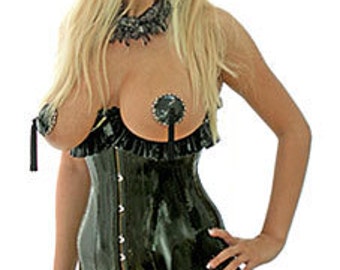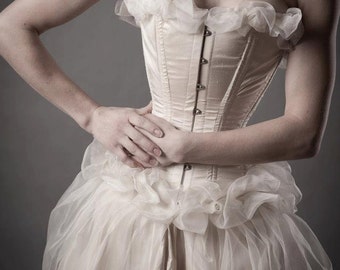Corsets For Women Biography
Source:- Google.com.pkFrom the Eric Hoffer panel of judges: "In 1922 Rebecca Latimer Felton became the first female U.S. Senator for the term of only one day. This accomplishment might seem insignificant if it were not for Felton’s long and active involvement in social reform and ultimately women’s suffrage. Born into the destruction of the plantation south, Felton’s life parallels the reformation of Georgia from the ashes. Staman is an engaging biographer and does well to show us the landscape as well as Felton’s intriguing course of events. You’ll finish this book remembering that there is a seat at the table for everyone, if we strive hard enough and demand the very best of ourselves."
Spanning nearly a century (1835-1930)the life of Rebecca Latimer Felton was profoundly changed by the disastrous effects of the Civil War and Reconstruction upon her beloved state of Georgia. Although she had once been a Southern Belle, then loving wife and mother on a large cotton plantation, she began to step out of the traditions expected by southern chivalry and tradition. With her husband's encouragement, she became a woman politician forty-seven years before she got the right to vote. A tireless crusader, her attempts at political and civil reform are set against the backdrop of a state in violent chaos. Sherman's matches, Reconstruction's graft, one-party corruption, the KKK, lynchers, hallelujah evangelicals, chain-gang convicts, the sneering H.L. Mencken "unsexed" suffragists, WCTU crusaders, and something possibly worse than anything else -- a tiny insect called the boll Weevil -- all strut or crawl or sweep across the pages of this work.
If you were sick in 1831, the year that Thomas Mütter graduated from medical school in Philadelphia, you might have been wise to avoid physicians altogether. America was a backwater of medicine. Doctors still clung to the ancient dogmas of Hippocrates and Galen, with grisly results. They drained lakefuls of blood with lancets and leeches, raised mountainous blisters with mustard poultices and gave mercury pills enough to cause a flood of diarrhea, turning their patients' bodies into topographies of pain.At best, these treatments were fearsome placebos for patients with depression and hypochondria. At worst, for those with typhoid, cholera and other serious infections, they increased the risk of death from dehydration and organ failure.
Mütter, the long-neglected subject of this lively and engaging biography by Cristin O'Keefe Aptowicz, was one of a handful of physicians who dragged American medicine into the modern era, helping to transform it into a powerhouse of scholarship and innovation.
When Mütter was born in 1811, he seemed to be a child of fortune. His mother was a bookish and beautiful product of Virginia's planter aristocracy, and his father was a well-to-do wheeler-dealer of Scottish stock. But both parents were tubercular and sickly, and their prosperity would prove illusory. By age 7, Mütter was an orphan. The son inherited his father's delicate lungs, restless ambition and debt-ridden estate.
Young Tom was packed off to boarding school and college, thanks to the erratic charity of a distant cousin, and eventually emerged as a cigar-smoking fop with mutton chop sideburns and a penchant for leghorn hats and silk cravats. After attending the young republic's premier medical school, the University of Pennsylvania, he went abroad to Paris, at that time the world's Mecca of medicine.
French medicine was skeptical, progressive and cruel, combining Enlightenment rationality and medieval brutality. Paris had two hospitals devoted entirely to the care of syphilis, one of which required all patients to be publicly whipped before and after treatment. The city also had a renowned school of anatomy, which solved the problem of cadaver disposal by feeding the remains to a pack of ravenous mongrels.
On the plus side, an American in Paris could watch technical wizards such as Roux, Lisfranc and Dupuytren at work in the operating theater. Philibert Roux was the most beloved of Parisian surgeons. His colleagues said he was "without fear, and beyond reproach." He was the first surgeon to successfully repair a ruptured female perineum, a dreaded complication of childbirth. Mütter greatly admired Roux's pioneering work in plastic surgery and cleft-palate correction.
Jacques Lisfranc was a surgical innovator and original thinker, daring to a fault. He treated a series of women with cervical cancer by amputating the cervix, leading to more deaths from hemorrhage and infection than cures. He is mainly remembered for describing a midfoot crush injury in a Napoleonic cavalryman who got his foot tangled in a stirrup while falling from his mount. Today, the Lisfranc injury is an occupational hazard of running backs and offensive linemen, and a bane of fantasy football owners.
Mütter also saw Paris's greatest surgeon, the brilliant and dastardly Baron Dupuytren, presiding over its greatest hospital, the Hôtel-Dieu. Pierre-François Percy, chief surgeon to the Grande Armée of Napoléon I, called Dupuytren "the best of surgeons, the worst of men." To Lisfranc, Dupuytren was "the brigand of the Hôtel-Dieu." Dupuytren was a self-made man, the workaholic son of a bankrupt country lawyer. As an impoverished medical student during the French Revolution, he had studied by the light of candles made of tallow filched from cadavers. In the operating room, he was a perfectionist, abiding by the motto "nothing is more to be despised than mediocrity." Driven by greed and sporadic fits of empathy, he outmaneuvered his colleagues to rise to the top of his profession and was awarded a barony by Louis XVIII. By the time of Mütter's sojourn in Paris, Dupuytren had become a brutal and domineering monster of conceit, literally leading patients around his clinic by their noses and throttling those who didn't follow his prescriptions.
Mütter admired the creativity, meticulous technique and cleanliness of Parisian physicians, while deploring their callousness. Seeing patients in agony was almost unbearable for Mütter. Colleagues said that he was "painfully sympathetic with the suffering of the patient," perhaps because as a child he had seen his parents waste away, and was himself always in poor health.
The young man made one additional discovery in the course of his travels: the umlaut. On his return to America in 1832, poor Tom Mutter the orphan became the more imposing Thomas Dent Mütter, Philadelphia social climber.
Mütter eventually found an academic home at the city's Jefferson Medical College (now Sidney Kimmel Medical College). Jefferson was brand new but had quickly become an elite institution, thanks to two distinctions that may not seem like much to us, but were remarkable at the time: The students saw patients early on in their training, in an era when live bodies were an afterthought at most medical schools, and the teachers actually put time and effort into their teaching.
Mütter was one of the first plastic surgeons in America. Plastic surgery seems to have been born in India, where the cutting off of noses was an ancient means of public punishment and private revenge. The absence of a nose being a grave social liability, there were many patients desperate for help. An anonymous Hindu brickmaker of genius came up with a solution, probably many centuries ago, and passed the secret down to his descendants. A wide flap of skin was cut from the middle of the forehead, swung downward, shaped into a plausible facsimile of a nose and sewn into place. A London surgeon named Carpue heard of the Indian method and used it in the early 1800s to restore noble British noses that had been lost to syphilis. Mütter used his own modification of this procedure to replace Yankee noses which had been bitten off in barroom brawls.
Mütter was also a pioneer of burn surgery. Victorian women worked around open fires while imprisoned in petticoats and corsets. Minor domestic mishaps could result in horrific burns, as with Miss Havisham in "Great Expectations." According to Ms. Aptowicz, the neck area was particularly vulnerable, being a "virtual powder keg in its combination of air, restrictive dense fabrics, and light airy layers of decorative cloth." Mütter operated on one young woman who had suffered such a burn in childhood. Thick layers of scar tissue on her neck had made her head immobile and distorted her face and jaw. He removed the scars and rotated a flap of skin from the neck and shoulder to fill in the defect. The procedure, now known as the "Mütter flap," was a complete success and is still used today.
Mütter bonded with his patients to a degree that his contemporaries must have found bizarre. He insisted that the medical school take care of patients overnight after surgery, instead of jolting them home over the Philadelphia cobblestones with their still-bloody incisions. Before his plastic surgeries, Mütter spent hours massaging the cleft palates, scars and gaping wounds that he planned to repair. He believed this would desensitize the tissues and make the operation easier. If nothing else, it promoted trust between patient and physician, enabling him to perform complex operations before the development of anesthesia. But Mütter was never satisfied with the status quo. When the first case report of anesthesia was published, Mütter became the first physician in Philadelphia to adopt it and championed its use.






